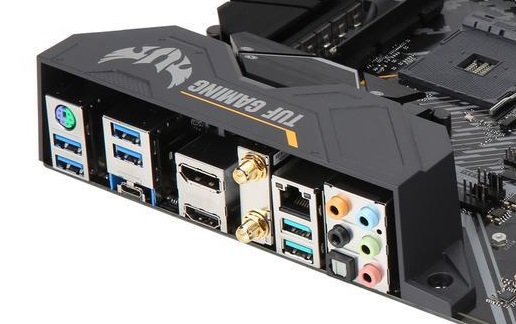The AMD X570 Motherboard Overview: Over 35+ Motherboards Analyzed
by Gavin Bonshor on July 9, 2019 8:00 AM ESTASUS TUF Gaming X570-Plus & X570-Plus WIFI
The ASUS TUF Gaming X570-Plus and TUF Gaming X570-Plus Wi-Fi motherboards both contain the same core componentry with a 12+2 phase power delivery, actively cooled X570 chipset heatsink, a Realtek S1200A HD audio codec, and both feature the new Realtek L8200A Gigabit LAN which is exclusive to ASUS at present. The only difference between the two models is that the TUF Gaming X570-Plus WIFI includes an Intel AC 9260 802.11ac wireless interface with BT 5.0 support included.
On the design, the aesthetic is reminiscent of previous TUF Gaming branded models with a grey and black patterned printing on the PCB, with grey industrial looking heatsinks. There are four memory slots with support for ECC and non-ECC DDR4 memory with a maximum capacity of up to 128 GB. The ASUS TUF Gaming X570-Plus pairing also includes two full-length PCIe 4.0 slots which run at x16 and x16/x4.
Included on the rear panel is an HDMI 1.4b, and DisplayPort video output, with two USB 3.1 G2 Type-A, and one USB 3.1 G2 Type-C port; also featured are four USB 3.1 G1 Type-A ports. A new addition to Realtek's NIC line up and exclusive to ASUS is an L8200A Gigabit NIC, with the WIFI model including an Intel AC 9260 802.11ac wireless interface. The five 3.5 mm audio jacks and S/PDIF optical output are controlled by a Realtek ALC1200A HD audio codec, and finishing off the rear panel is a PS/2 combo port for legacy keyboard and mice.
Both the ASUS TUF Gaming X570-Plus and TUF Gaming X570-Plus WIFI models represent its gaming-inspired entry level; ASUS rebranded the TUF series from durable and robust models, to more accessible models with a more modest outlay when compared to the Strix series. The ASUS TUF Gaming X570-Plus has an MSRP of $170, while the WIFI enabled version is slightly more expensive with an MSRP of $185.












225 Comments
View All Comments
DigitalFreak - Tuesday, July 9, 2019 - link
I think the only advantage of using a 2000 series CPU with an X570 board will be PCIe 3.0/4.0 support. The X370/X470 only supported PCIe 2.0. In theory, the connection from the 2000 processor to the X570 chipset should run at PCIe 3.0 speeds.FreckledTrout - Tuesday, July 9, 2019 - link
The x370 chipset and x470 both supported PCIe 3.0 with either a 1xxx or 2xxx Ryzen CPU. If you are not running a 3xxx CPU in the x570 board there isn't any major feature that should cause one to want to upgrade.DigitalFreak - Tuesday, July 9, 2019 - link
@FreckledTrout - Yes and no. The interconnect between the CPU and the chipset is PCIe 3.0 on X370 / X470, but all the PCIe lanes that come off the chipset are 2.0. Running a 2000 series CPU in an X570 board would give you a PCIe 3.0 link between the CPU and the chipset, with either PCIe 3.0 or 4.0 lanes coming off the chipset (depends on if AMD drops everything to PCIe 3.0 with a 2000 series processor).extide - Tuesday, July 9, 2019 - link
It looks like they still allow the chipset lanes to be 4.0. So you'd have 3.0 link to cpu, but 4.0 from chipset to devices.Targon - Thursday, July 11, 2019 - link
Since you have at least one or two PCI Express slots that are connected to the CPU, not chipset, that almost becomes a non-issue. On my Asus ROG Crosshair VI Hero(X370), you have PCI Express 3.0 x16 for the first slot, or x8/x8. The third PCI Express x16 slot is a 2.0 I believe, which is still enough to get the job done for many devices. Even with the X570 board with a first or second generation Ryzen processor, the most you end up with is an extra 3.0 supporting slot. Note that many boards may have x16 slots, but they are x8 electrically, so you won't see the full bandwidth anyway in those slots.sorten - Tuesday, July 9, 2019 - link
Thanks Gavin! This is a great resource and is exactly what I needed to help build my new system.willis936 - Tuesday, July 9, 2019 - link
The return of the 40mm fan! Those are the most obnoxious components ever. No one has missed them in the past ten years.Kastriot - Tuesday, July 9, 2019 - link
Buy Asrock aqua and problem solved.FreckledTrout - Tuesday, July 9, 2019 - link
I'm waiting for the next iteration of board for this reason. I'm speculating the next round the chipset will be on 7nm.abufrejoval - Tuesday, July 9, 2019 - link
The genious about that chiplet design is that the chipset doesn't actually benefit nearly as much from the shrink, as pure logic or SLC caches: The monolithic guys pay the 7nm overhead (e.g. EUV) for I/O while the geometry of the transistors in the I/O area is mostly determined by the need to power long motherbord or even slot traces.So while waiting is never a bad idea when your need clearly isn't overwhelming you, waiting for that shrink could turn out rather long. These days I/O heave chips might never be done in smaller geometries, because of that and because packaging has matured.